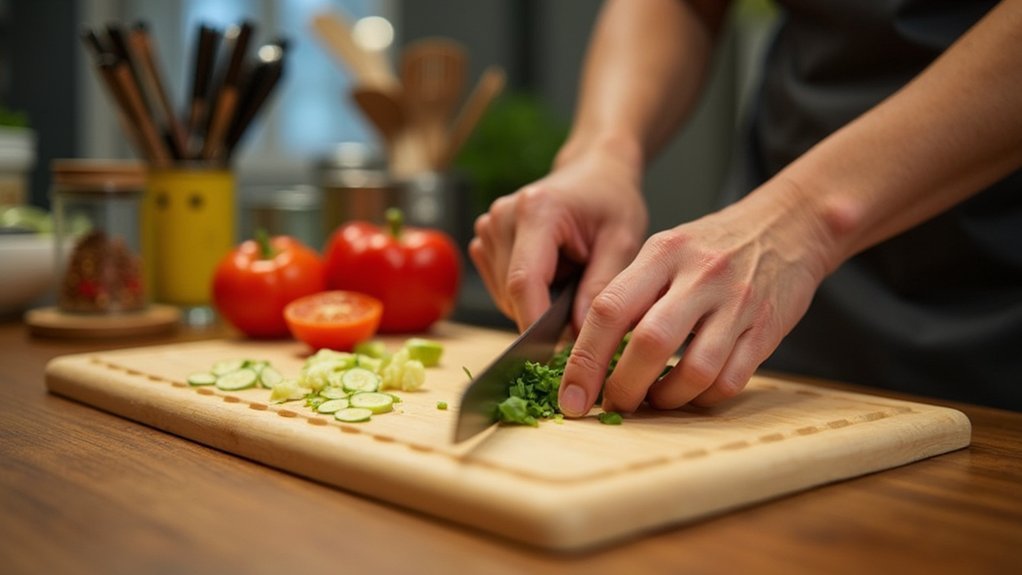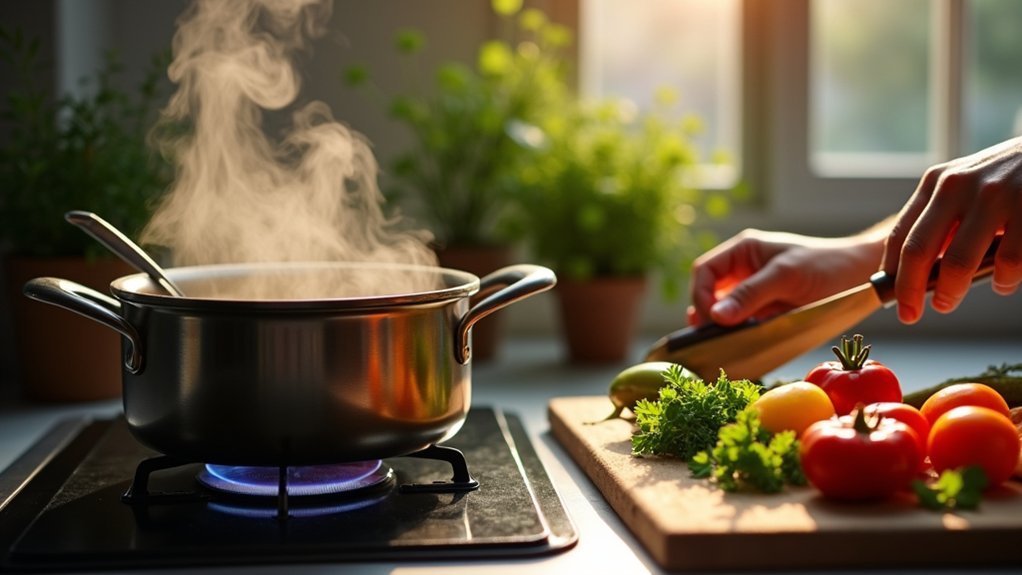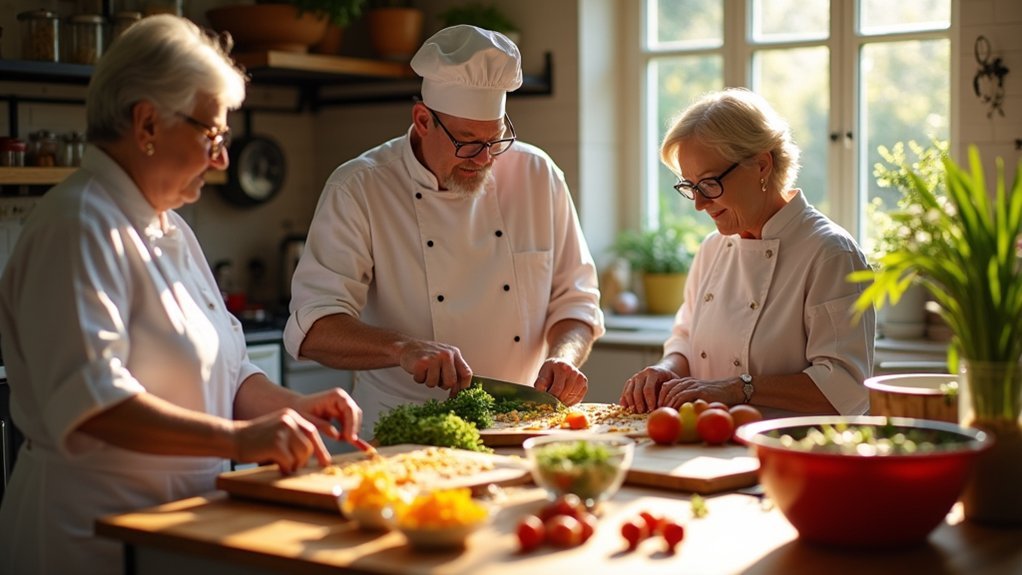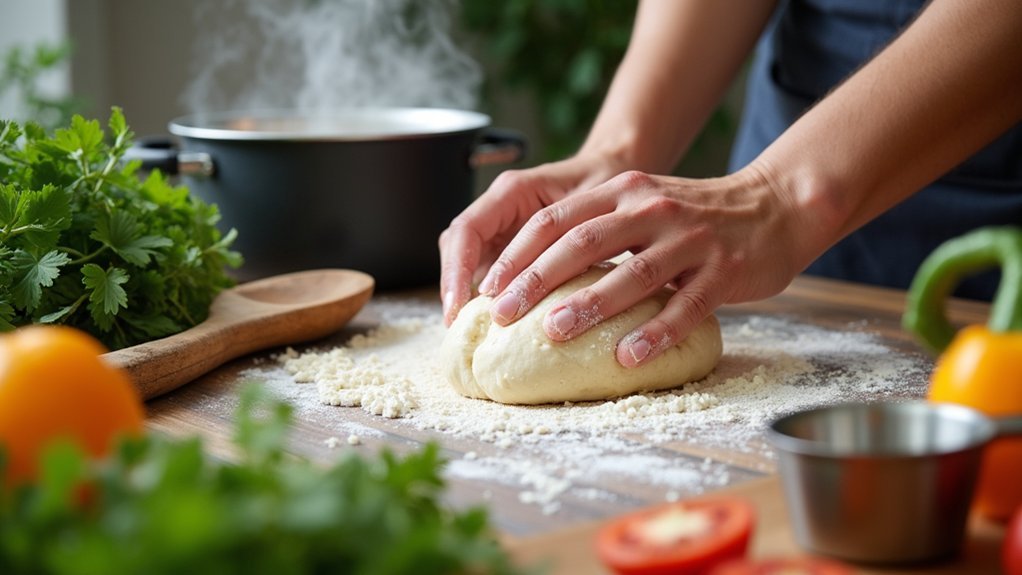Vision-impaired home chefs can thrive in the kitchen with these five techniques: organize your space with touch-based systems using consistent locations, master knife skills with adaptive tools like Knorks and textured cutting boards, use sound and smell cues to monitor cooking progress, simplify meal planning with batch preparation and voice assistants, and build confidence through community resources like workshops and online forums. These approaches will enhance your independence and safety while you create delicious meals your way.
The Touch-Based Kitchen Organization System

Anyone living with vision impairment knows that a well-organized kitchen becomes an extension of their senses. To create this sensory foundation, maintain consistent locations for all your items—consistency eliminates frustrating searches and builds spatial memory.
For those with visual impairments, a methodically arranged kitchen functions as a tactile map, extending perception beyond sight.
Use silverware dividers and designated drawers for different utensils to establish tactile familiarity. Store dry ingredients in various-sized canisters that you can identify by touch. Arrange non-slip containers to prevent items from sliding when you reach for them. Consider using a Microwave with Rotary Dial which is specifically designed for low vision users with its simple controls.
When cooking, place ingredients on the counter in recipe order to enhance your workflow. Consider adding tactile markers on storage containers, drawers, and appliance controls. Transparent stickers with angular textures allow you to identify settings while preserving underlying text visibility.
These simple adaptations transform your kitchen into an accessible, efficient workspace.
Mastering Knife Skills With Adaptive Tools
When confronted with the challenge of knife work, vision-impaired chefs can still master essential cutting techniques through specialized adaptive tools and sensory-focused approaches.
Start with tools like the Knork, which combines knife and fork functionality, reducing the need to switch between utensils.
Embrace tactile feedback by using cutting boards with raised edges or textured markers to guide your movements. The high-contrast design of specialized cutting boards like the Low Vision Black and White Cutting Board significantly improves visibility during food preparation. High-contrast utensils and non-slip mats can greatly improve your safety and precision.
Practice with soft fruits and vegetables first to build confidence.
Consider integrating technology into your practice—talking scales help with ingredient preparation, while voice assistants can guide you through complex techniques.
Join adaptive cooking classes or online communities where you’ll learn specialized techniques from others who share similar challenges.
Safe Cooking Methods Using Sound and Smell Cues

Despite common misconceptions, vision-impaired chefs can navigate the kitchen confidently by harnessing their other senses, particularly hearing and smell.
You’ll discover that cooking becomes intuitive when you listen for telltale sounds like the sizzle of food hitting a hot pan or the distinct bubble of boiling water signaling when to reduce heat.
Leverage your sense of smell to monitor cooking progress—aromatic spices and herbs help gauge doneness without visual confirmation.
Install tactile markers on stove knobs and appliances to adjust settings precisely by touch. Voice-activated scales and vibrating timers provide essential feedback during meal preparation.
For added safety, incorporate high-contrast colors in your kitchen setup and employ thermal feedback tools to assess cooking temperatures. Enhancing visibility while cooking can be achieved by using contrasting colored trays for different food items to distinguish between ingredients.
With these multisensory techniques, you’ll cook independently and effectively.
Simplified Meal Planning for Independent Food Preparation
Effective meal planning transforms cooking from a potentially stressful task into a streamlined, enjoyable experience for vision-impaired chefs. By dedicating time to weekly meal planning, you’ll reduce shopping trips and guarantee nutritional balance.
Use accessible tools like voice assistants or Braille notetakers to create organized shopping lists by store section, making grocery trips more efficient. When planning your meals, remember that batch preparation can save significant time during busy weekdays.
- Shop smarter – Visit stores during off-peak hours and select items with accessible packaging to maintain your independence and confidence.
- Embrace technology – Leverage apps like Be My Eyes for real-time shopping assistance and barcode scanners for nutritional information.
- Simplify your approach – Focus on single-pot recipes and implement a consistent labeling system using Braille or audio tags for ingredients and leftovers.
Building Confidence Through Community Resources and Support

Connecting with community resources and support networks serves as a cornerstone for vision-impaired chefs to build cooking confidence. Organizations like the National Federation of the Blind and Lighthouse for the Blind offer specialized workshops where you’ll learn adaptive cooking techniques and gain access to assistive technologies.
You’ll find invaluable support in online forums where fellow vision-impaired cooks share recipes, techniques, and solutions to common kitchen challenges. These communities help reduce isolation while providing practical advice for overcoming obstacles. Vision rehabilitation agencies provide home visits to help set up an accessible kitchen environment tailored to your specific needs.
Draw inspiration from role models like Christine Ha, the blind chef who won MasterChef in 2012, proving vision isn’t a barrier to culinary excellence.
Through dedicated training programs, you’ll develop essential skills in kitchen organization, safety protocols, and effective use of assistive tools—building your independence one recipe at a time.
Frequently Asked Questions
How Do I Safely Identify Spices Without Sight?
You can safely identify spices using Braille labels, tactile markings, or organization systems. Rely on your sense of smell to recognize aromas. Consider magnetic labels, texture identification, and keeping a Braille reference list for verification.
What Techniques Help With Pouring Hot Liquids Safely?
Use wider containers as targets, employ liquid level indicators, and pour over sinks or trays. You’ll feel heat from a safe distance. Always use tactile markings and keep your workspace organized to prevent accidents.
How Can I Tell When Meat Is Properly Cooked?
You can tell meat’s properly cooked by using a Braille thermometer, feeling for firmness with your fingertips, smelling for rich aromas, and timing the cooking process based on the meat’s thickness and type.
Which Appliances Are Most Accessible for Vision-Impaired Chefs?
You’ll find talking microwaves, Instant Pots with tactile buttons, and appliances with audio feedback most accessible. Look for high-contrast displays, jumbo timers, and models with sensory feedback that don’t rely on visual cues.
How Do I Handle Unexpected Kitchen Spills Efficiently?
Turn off heat sources immediately when you notice a spill. Use contrasting cleaning tools you’ve strategically placed around your kitchen. Don’t rush cleanup—ensure the surface is completely dry to prevent slips and falls.
In Summary
You’ve now discovered five powerful techniques to navigate your kitchen confidently despite vision impairment. By organizing tactilely, adapting knife skills, cooking with sensory awareness, simplifying meal planning, and connecting with supportive communities, you’re well-equipped to create delicious meals independently. Remember, these methods aren’t just about cooking—they’re about reclaiming your kitchen autonomy. With practice and persistence, you’ll continue to build skills that enhance both your culinary abilities and self-reliance.





Leave a Reply